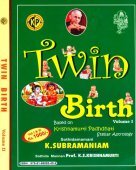Bharani, Bharaṇī, Bharaṇi: 19 definitions
Introduction:
Bharani means something in Buddhism, Pali, Hinduism, Sanskrit, Marathi, Jainism, Prakrit, biology. If you want to know the exact meaning, history, etymology or English translation of this term then check out the descriptions on this page. Add your comment or reference to a book if you want to contribute to this summary article.
Images (photo gallery)
In Hinduism
Jyotisha (astronomy and astrology)
Source: Wisdom Library: JyotiṣaBharaṇī (भरणी):—Name for a particular section of the ecliptic. It is also known as Bharaṇīnakṣatra. Nakṣatra means “Lunar mansion” and corresponds to a specific region of the sky through which the moon passes each day. Bharaṇī means “the bearer” and is associated with the deity known as Yama (God of death). The presiding Lord of this lunar house is Śukra (Venus).
Indian zodiac: |13° 20'| – |26° 40' Meṣa|
Meṣa (मेष, ‘ram’) corresponds with Aries
Western zodiac: |9° 20'| – |22° 40' Taurus|
Taurus corresponds with Vṛṣabha (वृषभ, ‘bull’).

Jyotisha (ज्योतिष, jyotiṣa or jyotish) refers to ‘astronomy’ or “Vedic astrology” and represents the fifth of the six Vedangas (additional sciences to be studied along with the Vedas). Jyotisha concerns itself with the study and prediction of the movements of celestial bodies, in order to calculate the auspicious time for rituals and ceremonies.
Purana and Itihasa (epic history)
Source: archive.org: Puranic EncyclopediaBharaṇī (भरणी).—One of the twentyseven constellations. Puṇya is assured if one gives as gift a cow to a brahmin on that day. (Śloka 35, Chapter 64, Anuśāsana Parva, Mahābhārata).
Source: Cologne Digital Sanskrit Dictionaries: The Purana IndexBharaṇi (भरणि).—A nakṣatra: fit for performing śrāddha.*
- * Brahmāṇḍa-purāṇa III. 18. 14; Vāyu-purāṇa 82. 14.

The Purana (पुराण, purāṇas) refers to Sanskrit literature preserving ancient India’s vast cultural history, including historical legends, religious ceremonies, various arts and sciences. The eighteen mahapuranas total over 400,000 shlokas (metrical couplets) and date to at least several centuries BCE.
Vastushastra (architecture)
Source: Wisdom Library: Vāstu-śāstraBharaṇī (भरणी) refers to the second of twenty-seven constellations (ṛkṣa), according to the Mānasāra. Ṛkṣa is the third of the āyādiṣaḍvarga, or “six principles” that constitute the “horoscope” of an architectural or iconographic object. Their application is intended to “verify” the measurements of the architectural and iconographic object against the dictates of astrology that lay out the conditions of auspiciousness.
The particular nakṣatra, also known as ṛkṣa (e.g., bharaṇī) of all architectural and iconographic objects (settlement, building, image) must be calculated and ascertained. This process is based on the principle of the remainder. An arithmetical formula to be used in each case is stipulated, which engages one of the basic dimensions of the object (breadth, length, or perimeter/circumference). In the context of village planning and measurement, the text sates that among the stars (ṛkṣa), the ones that are pūrṇa (odd), are auspicious and the ones that are karṇa (even), inauspicious.

Vastushastra (वास्तुशास्त्र, vāstuśāstra) refers to the ancient Indian science (shastra) of architecture (vastu), dealing with topics such architecture, sculpture, town-building, fort building and various other constructions. Vastu also deals with the philosophy of the architectural relation with the cosmic universe.
Ayurveda (science of life)
Toxicology (Study and Treatment of poison)
Source: Shodhganga: Kasyapa Samhita—Text on Visha ChikitsaBharaṇi (भरणि) (Nakṣatra) is considered negative for the recovery for a person to be bitten by snake, as taught in the Kāśyapa Saṃhitā: an ancient Sanskrit text from the Pāñcarātra tradition dealing with both Tantra and Viṣacikitsā—an important topic from Āyurveda which deals with the study of Toxicology (Agadatantra or Sarpavidyā).—The malignant asterisms and baneful lunar phases and astral combinations, with reference to snake-bite, are discussed in the tail-end of the fourth Adhyāya. [...] The Kāśyapasaṃhitā mentions the following details regarding the Nakṣatras:—The stars of a malignant nature that determine the virulence of the poison of the snake bite are [e.g., Bharaṇi] (Cf. verse IV.108)

Āyurveda (आयुर्वेद, ayurveda) is a branch of Indian science dealing with medicine, herbalism, taxology, anatomy, surgery, alchemy and related topics. Traditional practice of Āyurveda in ancient India dates back to at least the first millenium BC. Literature is commonly written in Sanskrit using various poetic metres.
General definition (in Hinduism)
Source: archive.org: Vedic index of Names and SubjectsApabharaṇīs, Bharaṇī (अश्विनी), or Bharaṇyas (‘the bearers’) is the name of the small triangle in the northern part of the Ram known as Musca or 35, 39, and 41 Arietis.
In Buddhism
Tibetan Buddhism (Vajrayana or tantric Buddhism)
Source: Wisdom Library: Tibetan BuddhismBharaṇī (भरणी) refers to one of the various Nakṣatras mentioned as attending the teachings in the 6th century Mañjuśrīmūlakalpa: one of the largest Kriyā Tantras devoted to Mañjuśrī (the Bodhisattva of wisdom) representing an encyclopedia of knowledge primarily concerned with ritualistic elements in Buddhism. The teachings in this text originate from Mañjuśrī and were taught to and by Buddha Śākyamuni in the presence of a large audience (including Bharaṇī).
Source: archive.org: The Indian Buddhist IconographyBharaṇī (भरणी) refers to the second of the 28 nakṣatras (“constellations”) of the zodiac, as commonly depicted in Buddhist Iconography, and mentioned in the 11th-century Niṣpannayogāvalī of Mahāpaṇḍita Abhayākara.—The nakṣatras are described collectively in the dharmadhātuvāgīśvara-maṇḍala of the Niṣpannayogāvalī. In this maṇḍala the nakṣatras are given one face and two arms, which are clasped against the chest in the añjalimudrā:—“the deities [viz., Bharaṇī] are decked in bejewelled jackets and they all show the añjali-mudrā”.—In colour, however, they differ. [viz., Bharaṇī is given the colour green].

Tibetan Buddhism includes schools such as Nyingma, Kadampa, Kagyu and Gelug. Their primary canon of literature is divided in two broad categories: The Kangyur, which consists of Buddha’s words, and the Tengyur, which includes commentaries from various sources. Esotericism and tantra techniques (vajrayāna) are collected indepently.
Mahayana (major branch of Buddhism)
Source: archive.org: Bulletin of the French School of the Far East (volume 5)Bharaṇī (भरणी) is the name of a Nakṣatra mentioned in chapter 18 of the Candragarbha: the 55th section of the Mahāsaṃnipāta-sūtra, a large compilation of Sūtras (texts) in Mahāyāna Buddhism partly available in Sanskrit, Tibetan and Chinese.—Chapter 18 deals with geographical astrology and, in conversation with Brahmarāja and others, Buddha explains how he entrusts the Nakṣatras [e.g., Bharaṇī] with a group of kingdoms for the sake of protection and prosperity.
The Bharaṇīnakṣatra comprises the following realms:
- A-sseu-na-ki (Asenaki?),
- Kiun-t'o-lo-p'i (Kunaravi?),
- Ngan-ni-che (Aṃniśi?),
- Tchö-kiu-po (Cakopa?),
- Teou-kia-ti (Dugati?),
- Pou-tche (Puci?),
- Tche-to-p'i-si-ti (Citavisiti?),
- Yeou-chai-ti (Oṣadhi?),
- Pan-t'eou-po-lo (Bandhupāla?),
- P'i-lo-li-kia (Viralika?),
- Mo-t'o-lo-p'i (Madaravi?),
- Kia-na-po-ti (Kanapati?),
- Ta-p'o-so-li (Tavasari?).

Mahayana (महायान, mahāyāna) is a major branch of Buddhism focusing on the path of a Bodhisattva (spiritual aspirants/ enlightened beings). Extant literature is vast and primarely composed in the Sanskrit language. There are many sūtras of which some of the earliest are the various Prajñāpāramitā sūtras.
Biology (plants and animals)
Source: Google Books: CRC World Dictionary (Regional names)Bharani in India is the name of a plant defined with Vitex altissima in various botanical sources. This page contains potential references in Ayurveda, modern medicine, and other folk traditions or local practices It has the synonym Vitex appendiculata Willd. (among others).
Example references for further research on medicinal uses or toxicity (see latin names for full list):
· Phytologia (1971)
· Phytochemistry (1707)
· Journal of Natural Products (2012)
· Phytotherapy research (2007)
· Flora of the British India (1885)
· Bulletin de la Société Imperiale des Naturalistes de Moscou (1863)
If you are looking for specific details regarding Bharani, for example diet and recipes, pregnancy safety, side effects, chemical composition, health benefits, extract dosage, have a look at these references.

This sections includes definitions from the five kingdoms of living things: Animals, Plants, Fungi, Protists and Monera. It will include both the official binomial nomenclature (scientific names usually in Latin) as well as regional spellings and variants.
Languages of India and abroad
Marathi-English dictionary
Source: DDSA: The Molesworth Marathi and English Dictionarybharaṇī (भरणी).—f (Verbal of bharaṇēṃ) Filling up, in, into, on. See the verb. 2 Filling material,--earth, stones &c. for filling up.
--- OR ---
bharaṇī (भरणी).—f (S) The second of the twenty-seven lunar asterisms. 2 or bharaṇīśrāddha n Oblation to the manes of a defunct under this asterism in bhādrapada- vadya within the twelve month after his decease.
--- OR ---
bhāraṇī (भारणी).—f (Verbal of bhāraṇēṃ) Charming &c. lit. fig. 2 A formula to charm; a charm or spell. v ghāla, ṭāka.
Source: DDSA: The Aryabhusan school dictionary, Marathi-Englishbharaṇī (भरणी).—f Filling up. Filling material. The second of the twenty-seven lunar asterisms. Oblation to the manes of a defunct under this asterism in bhādrapada vadya within the twelve months after his decease.
Marathi is an Indo-European language having over 70 million native speakers people in (predominantly) Maharashtra India. Marathi, like many other Indo-Aryan languages, evolved from early forms of Prakrit, which itself is a subset of Sanskrit, one of the most ancient languages of the world.
Sanskrit dictionary
Source: DDSA: The practical Sanskrit-English dictionaryBharaṇī (भरणी).—Name of the second constellation containing three stars.
Source: Cologne Digital Sanskrit Dictionaries: Monier-Williams Sanskrit-English Dictionary1) Bharaṇī (भरणी):—[from bharaṇa > bhara] a f. See below
2) Bharaṇi (भरणि):—[from bhara] mf. ([probably]) Name of a Nakṣatra (= bharaṇī), [Siddhānta-kaumudī]
3) Bharaṇī (भरणी):—[from bhara] b f. (of ṇa) Luffa Foetida or a similar plant, [cf. Lexicographers, esp. such as amarasiṃha, halāyudha, hemacandra, etc.]
4) [v.s. ...] (also [plural]) Name of the 7th Nakṣatra (containing 3 stars and figured by the pudendum muliebre), [Atharva-veda]; etc.
Source: DDSA: Paia-sadda-mahannavo; a comprehensive Prakrit Hindi dictionary (S)Bharaṇī (भरणी) in the Sanskrit language is related to the Prakrit word: Bharaṇī.
[Sanskrit to German]
Sanskrit, also spelled संस्कृतम् (saṃskṛtam), is an ancient language of India commonly seen as the grandmother of the Indo-European language family (even English!). Closely allied with Prakrit and Pali, Sanskrit is more exhaustive in both grammar and terms and has the most extensive collection of literature in the world, greatly surpassing its sister-languages Greek and Latin.
Prakrit-English dictionary
Source: DDSA: Paia-sadda-mahannavo; a comprehensive Prakrit Hindi dictionaryBharaṇī (भरणी) in the Prakrit language is related to the Sanskrit word: Bharaṇī.
Prakrit is an ancient language closely associated with both Pali and Sanskrit. Jain literature is often composed in this language or sub-dialects, such as the Agamas and their commentaries which are written in Ardhamagadhi and Maharashtri Prakrit. The earliest extant texts can be dated to as early as the 4th century BCE although core portions might be older.
Kannada-English dictionary
Source: Alar: Kannada-English corpusBharaṇi (ಭರಣಿ):—
1) [noun] a small box or chest, as for valuables; a casket.
2) [noun] the second of the twenty seven stars, which are considered astrologically important.
3) [noun] rain that comes during the association of this star with the moon (approx. during April-May).
4) [noun] ಭರಣಿಯಲ್ಲಿ ಹುಟ್ಟಿದವನು ಧರಣಿ ಆಳುವನು [bharaniyalli huttidavanu dharani aluvanu] bharaṇiyalli huṭṭidavanu dharaṇiāḷuvanu (prov.) (a belief that) a person whose birth star is ಭರಣಿ, [bharani,] will rule the nation.
Kannada is a Dravidian language (as opposed to the Indo-European language family) mainly spoken in the southwestern region of India.
See also (Relevant definitions)
Starts with: Bharanibhu, Bharaniga, Bharanige, Bharanika, Bharanikkhepana, Bharaninakshatra, Bharanishena, Bharaniya.
Ends with: Apabharani, Cauthabharani, Dubbharani, Durbharani, Gharabharani, Kumbharani, Mangalabharani, Payabharani, Sambharani, Surabharani, Ubharani, Vidyabharani.
Full-text (+121): Bharanibhu, Yamadevata, Nagavithi, Apabharani, Bharanya, Yamesha, Bharanishena, Bharanyahva, Yamya, Bharaninakshatra, Nakshatra, Bharana, Yamyam, Apabhartri, Vidyabharani, Sambharani, Yamarksha, Makaparani, Puci, Asenaki.
Relevant text
Search found 33 books and stories containing Bharani, Bharaṇī, Bharaṇi, Bhāraṇī; (plurals include: Bharanis, Bharaṇīs, Bharaṇis, Bhāraṇīs). You can also click to the full overview containing English textual excerpts. Below are direct links for the most relevant articles:
Brihat Samhita (by N. Chidambaram Iyer)
Chapter 9 - On the course of Venus (śukra-cāra)
Chapter 10 - On the course of Saturn (śanaiścara-cāra)
Appendix 3 - List of 28 yogatārās (chief stars) of the constellations (nakṣatras)
The Agni Purana (by N. Gangadharan)
Chapter 121 - The science of Jyotiṣa (Astronomy and Astrology) [jyotiḥśāstra]
Chapter 126 - Combinations of good and bad asterisms (nakṣatra-nirṇaya)
Chapter 136 - The diagram of asterisms indicating the period for undertaking a journey
Sankhayana-grihya-sutra (by Hermann Oldenberg)
The Garuda Purana (by Manmatha Nath Dutt)
Chapter LIX - Discourses on Astrology < [Agastya Samhita]
Chapter CLXXXI - The Nidanam of poisons < [Dhanvantari Samhita]
Mahabharata (English) (by Kisari Mohan Ganguli)
Section CX < [Anusasanika Parva]
Section LXXXIX < [Anusasanika Parva]
Section LXIV < [Anusasanika Parva]
The Brahmanda Purana (by G.V. Tagare)
Chapter 18 - Performance of Śrāddha under different Constellations (Nakṣatra) < [Section 3 - Upodghāta-pāda]
Chapter 3 - The race of Dharma: three attributes of the self-born God < [Section 3 - Upodghāta-pāda]
Chapter 24 - The arrangement of the heavenly luminaries < [Section 2 - Anuṣaṅga-pāda]
Related products



